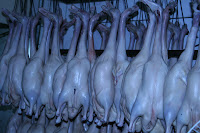I'm doing a single post of these cities because the old part of these cities we visited, though different, looked similar. Kunming was the only exception as it does not have an "old city". Commercial centres with modern offices and shopping centres are located outside the old city walls and we didn't see much of them.
Some of us only stayed one night at Shangri-La (old name ZhongDian), others two. That was because 7 of us were scheduled to go trekking at the Tiger Leaping Gorge (see next post - some great photos taken there) early the following morning. Here are a couple of photos of Shangri-La's old town taken early in the morning.


And, just in case if your are wondering if the people in Shangri-La ever grow old (as in the novel "Lost Horizon"), yes they do, like you and I. One interesting point though, the old people (and not so old ones) were being paid by the government (presumably in the form of a pension) to dance for an hour or so each day in this square. Some tourists joined in the fun - dancing - too:
After the excursion to Tiger Leaping Gorge, we rejoined the group in Lijiang - the number one most visited city in China. I can understand why. The old city is well preserved and tourists must pay an admission fee (80Yuan each, approx US12) to visit or stay in the old city. There were thousands of visitors each day, so there is not fear of shortage of funds for their maintenance programme.


Photos: These Lijiang streets would normally be full of visitors. The only way to beat the crowd is to get up early and get in there. Night time would be the worst time to visit the streets of old Lijiang because the crowd normally peaks at about dinner time until late. Photos: Lijiang, early in the morning. These streets were normally full of visitors.


The entrance to the Mo residence. Layout is similar to an imperial palace. In history, the Mo family were the lords of Lijiang - probably of interest to Chinese historians only.

Le and I took this picture infront of the residence of a family of scholars - the Tower of Knowledge. Two brothers and one of their siblings passed the Imperial exams - probably the only time in Chinese history.

We did not enjoyed Lijiang as much as we did Dali, probably because the crowd was much smaller in the latter.


In Dali, we enjoyed the walk through the park and saw how the Chinese, particularly the older generation spent their leisure time. The oldies were singing and there was an impromptus orchestra form and played their music. The second man from the right was the foreman of this orchestra:

Like Shangri-La and Lijiang (an indeed most of the Chinese cities) the oldies were out dancing in thetown square in early evenings:

While we were there, there was a photographers' convention happening and many photographs were exhibited in various old buildings which made the visit well worthwhile.
A couple of shots of how they prepare ducks :


.... Next Post - Tiger Leaping Gorge ..... promising stunning photos.































































